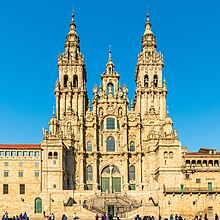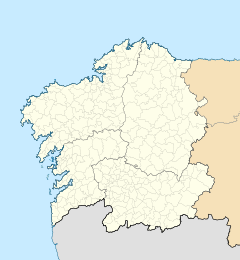| Metropolitan Archcathedral Basilica of Santiago de Compostela | |
|---|---|
 The western façade of the Metropolitan Archcathedral Basilica as seen from the Praza do Obradoiro | |
| Religion | |
| Affiliation | Catholic |
| District | Santiago de Compostela |
| Rite | Roman Rite |
| Leadership | Archbishop Francisco José Prieto Fernández |
| Location | |
| Location | Santiago de Compostela, Galicia, Spain |
| Geographic coordinates | 42°52′50″N 08°32′40″W / 42.88056°N 8.54444°W |
| Architecture | |
| Type | Metropolitan Archcathedral-Basilica |
| Style | Romanesque, Gothic, Baroque |
| Groundbreaking | 1075 |
| Completed | 1211 |
| Specifications | |
| Direction of façade | West |
| Capacity | 1,200 |
| Length | 100 m (330 ft) |
| Width | 70 m (230 ft) |
| Height (max) | 75 m (246 ft) |
| Spire(s) | 2 |
| Official name: Santiago de Compostela (Old Town) | |
| Criteria | i, ii, vi |
| Designated | 1985[1] |
| Reference no. | 320bis |
| Official name: Catedral Igrexa Catedral Metropolitana | |
| Designated | 22 August 1896 |
| Reference no. | (R.I.) - 51 - 0000072 - 00000[2] |
| Website | |
| catedraldesantiago.es | |
The Santiago de Compostela Arch cathedral Basilica (Spanish and Galician: Catedral Basílica de Santiago de Compostela) is part of the Metropolitan Archdiocese of Santiago de Compostela and is an integral component of the Santiago de Compostela World Heritage Site in Galicia, Spain. The cathedral is the reputed burial place of Saint James the Great, one of the apostles of Jesus Christ. It is also among the remaining churches in the world built over the tomb of an apostle, the other ones being St Peter's Basilica in Vatican City, St Thomas Cathedral Basilica in Chennai, India and Basilica of St. John in Izmir, Turkey.
The archcathedral basilica has historically been a place of pilgrimage on the Way of St James since the Early Middle Ages and marks the traditional end of the pilgrimage route. The building is a Romanesque structure, with later Gothic and Baroque additions.
- ^ "Santiago de Compostela (Old Town)". Whc.unesco.org. Archived from the original on 2011-05-14. Retrieved 2011-01-10.
- ^ "Catedral Igrexa Catedral Metropolitana". Patrimonio Historico – Base de datos de bienes inmuebles (in Spanish). Ministerio de Cultura. Archived from the original on 6 January 2019. Retrieved 9 January 2011.

